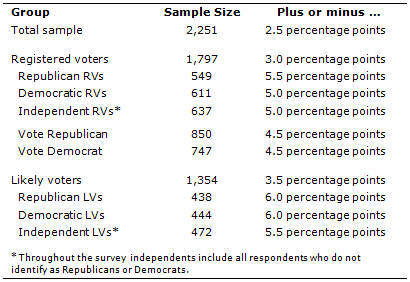Results for this survey are based on telephone interviews conducted October 13-18, 2010 among a national sample of 2,251 adults 18 years of age or older living in the continental United States (1,487 respondents were interviewed on a landline telephone, and 764 were interviewed on a cell phone, including 311 who had no landline telephone). Interviewing was conducted under the direction of Princeton Survey Research Associates International. Both the landline and cell phone samples were provided by Survey Sampling International. Interviews were conducted in English. For detailed information about our survey methodology, see: https://www.pewresearch.org/politics/methodology/
The combined landline and cell phone sample are weighted using an iterative technique that matches gender, age, education, race/ethnicity, region, and population density to parameters from the March 2009 Census Bureau’s Current Population Survey. The sample also is weighted to match current patterns of telephone status and relative usage of landline and cell phones (for those with both), based on extrapolations from the 2009 National Health Interview Survey. The weighting procedure also accounts for the fact that respondents with both landline and cell phones have a greater probability of being included in the combined sample and adjusts for household size within the landline sample. Sampling errors and statistical tests of significance take into account the effect of weighting. The following table shows the error attributable to sampling that would be expected at the 95% level of confidence for different groups in the survey:

In addition to sampling error, one should bear in mind that question wording and practical difficulties in conducting surveys can introduce error or bias into the findings of opinion polls.
Likely Voter Scale and Competitive Districts
Likely voter estimates are based on a 7-item turnout scale that includes the following questions: thought, precinct, q6, oftvote, plan1, scale10 and pvote08a. More details about the Pew Research Center’s methodology for estimating likelihood to vote are available at: https://www.pewresearch.org/politics/methodology/files/UnderstandingLikelyVoters.pdf
Competitive house districts were identified using ratings for each district from early October by Congressional Quarterly, The Cook Political Report, NBC News, The New York Times, and Real Clear Politics. Averaging the ratings by these different groups yields 77 competitive districts (rated as tossup or lean Republican or Democrat) and 358 safe districts (rated as likely or solid Republican or Democrat). A complete list of competitive districts is available upon request.